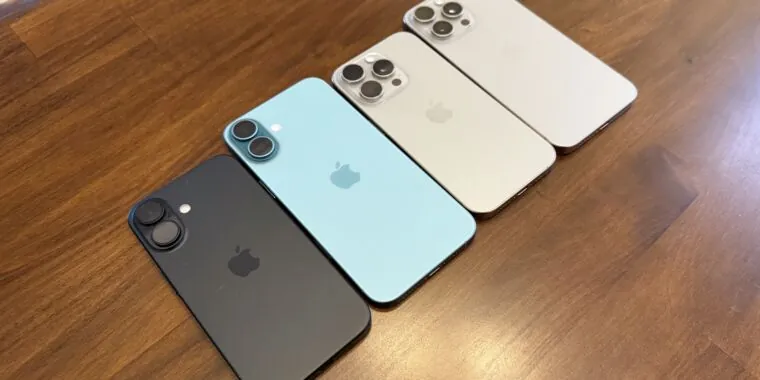
Is the iPhone 16 and 16 Pro the Upgrade You've Been Waiting For?
2024-09-26
Author: Lok
In the world of smartphones, Apple’s latest offerings, the iPhone 16 and iPhone 16 Pro, signify a crucial shift in the tech landscape. Gone are the days of radical transformations every year; what we see now is a series of subtle yet noteworthy refinements, some of which may not even reveal their true potential until future software updates with iOS 18 roll out.
While these devices do not introduce groundbreaking innovations, they certainly elevate the user experience, especially for those still using an iPhone 13 or older. Here's why many enthusiasts might feel that switching to the iPhone 16 represents a significant leap forward.
Specifications at a Glance
**Models:** iPhone 16, 16 Plus, 16 Pro, 16 Pro Max **Display:** - iPhone 16: 6.1-inch OLED (2556x1179) - iPhone 16 Plus: 6.7-inch OLED (2796x1290) - iPhone 16 Pro: 6.3-inch OLED (2622x1206) - iPhone 16 Pro Max: 6.9-inch OLED (2868x1320) **Chipset:** - iPhone 16 & 16 Plus: Apple A18 Bionic - iPhone 16 Pro & Pro Max: Apple A18 Pro **Storage Options:** 128GB, 256GB, 512GB, and up to 1TB for Pro models **Camera Setup:** - iPhone 16/16 Plus: 48MP main, 12MP ultra-wide - iPhone 16 Pro/Pro Max: 48MP main, 48MP ultra-wide, 12MP 5x telephoto **Other Features:** Wi-Fi 7, USB-C, 5G connectivity, MagSafe, Face ID With starting prices from $799 for the iPhone 16 to $1,199 for the Pro Max, Apple continues to position itself as a premium brand in the smartphone market.
The Eye-Popping Displays
The devices boast stunning OLED displays with impressive brightness and color accuracy. While the iPhone 16 features a standard refresh rate of 60Hz, the Pro models offer a dazzling 120Hz refresh rate, providing smoother scrolling and enhanced gaming experiences. However, keep in mind that this standard is becoming commonplace among Android competitors.
Additionally, both Pro models now feature an ‘always-on’ display—ideal for quick glances at notifications without waking up the device. This small comfort reflects what many users have come to expect from high-end smartphones today.
Performance Boosts
Under the hood, the iPhone 16 series is powered by the state-of-the-art A18 processor. With improved CPU and GPU performance, users can expect faster processing and less power consumption. This is bolstered by an increase in RAM from 6GB to 8GB for the non-Pro models, marking a noteworthy advancement.
Moreover, the A18 Pro chip elevates the Pro models with an extra GPU core, harnessing the potential for breathtaking gaming visuals—if only a wider range of titles fully utilized this capability!
Camera Capabilities Redefined
The camera system across all models has received updates, with both Pro variants showcasing notable advancements in photography. From 48MP main cameras to impressive ultra-wide capabilities, capturing stunning photos is easier than ever. The improvements in image processing powered by the A18 chips mean that your perfectly framed sunset shot will be even more vibrant and detailed.
What About Apple Intelligence?
One of the most talked-about aspects leading up to this launch is "Apple Intelligence," a suite of generative AI features that, while not yet available, promises to enhance the iPhone experience down the line. Although it’s tempting to speculate about what these features might entail, it's crucial to evaluate the current functionality of the devices as they stand today. Rest assured, when these features are released, they will surely be a focal point of discussion.
Conclusion
The iPhone 16 and 16 Pro may appear to be subtle updates at first glance, but upon closer examination, they present tangible improvements in performance, camera technology, and user experience. If you’re currently using an iPhone 13 or older, upgrading to these latest models may well be worth your investment.
So, are the iPhone 16 and 16 Pro the upgrade you’ve been waiting for? If you value refinement over radical change and are anticipating future features like Apple Intelligence, the answer is likely YES! Stay tuned as Apple continues to evolve the smartphone realm, one incremental update at a time.




 Brasil (PT)
Brasil (PT)
 Canada (EN)
Canada (EN)
 Chile (ES)
Chile (ES)
 España (ES)
España (ES)
 France (FR)
France (FR)
 Hong Kong (EN)
Hong Kong (EN)
 Italia (IT)
Italia (IT)
 日本 (JA)
日本 (JA)
 Magyarország (HU)
Magyarország (HU)
 Norge (NO)
Norge (NO)
 Polska (PL)
Polska (PL)
 Schweiz (DE)
Schweiz (DE)
 Singapore (EN)
Singapore (EN)
 Sverige (SV)
Sverige (SV)
 Suomi (FI)
Suomi (FI)
 Türkiye (TR)
Türkiye (TR)